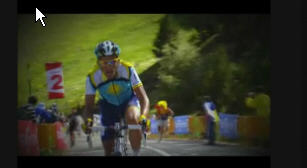16 Jul The Tour de France, Mental Concentration, and Healing Trauma: Before the 2010 July ezine article was this 2005 essay
That's right. The date is no mistake. It's late at night — or early in the morning and I'm cleaning out files. I stumbled on this piece that I wrote in 2005 toward the end of that Tour de France, the one that Lance Armstrong won for the seventh consecutive time.
I had gotten so many emails thanking me for my last ezine which explored what the Tour de France, meditation, and healing trauma had in common. That ezine had its start in this piece of writing I did many years ago.
Mental Concentration
Watching Lance Armstrong compete in the 2005 Tour de France I could clearly see his one pointed commitment to winning. It was especially visible in his dedication to winning the last time trial yesterday. That time trial, however, showed the culmination of his unwavering focus throughout the year.
Today, on the last day of the Tour de France I went to the gym after I saw the race (on TV that is!)
I pushed myself and while doing so I watched how different thoughts really effected my focus. Thoughts like, “boy, I don’t feel like it today” would cause me to ease back on my push. Other days, when I might feel a little despondent about something and I would let my focus turn to those feelings, I might even cut my workout short. Those days when my energy is upbeat it’s easy to push a little harder, do a little more, and enjoy myself while I am doing it.
Healing trauma is very much like this. When we feel caught by the feelings and thoughts of how hard the healing is, we don’t feel motivated to do much of anything, and certainly can’t imagine it getting any better.
Learning to develop some form of concentration practice helps train the mind to focus and direct it’s energy toward some point rather than wandering aimlessly, or being caught by the next thought or feeling that arises.
One of my favorite concentration practices is the Buddhist practice of metta (Loving Kindness). The practice of metta is one of four pillars (loving kindness, equanimity, contentment, compassion) that help hold the mind in an easeful state.
I learned about this practice while in the depths of my own healing at a retreat at the Insight Meditation Society in Barre, MA. Sharon Salzburg led that retreat and has made metta a strong meditation practice here in the US. Her book, Loving Kindness: The Revolutionary Art of Happiness is a wonderful guide for learning the practice.
Practicing metta is helpful for a lot of trauma survivors since so many of us don’t believe that any kind of kindness is available. When we're caught in the cycles of our healing we might believe kindness is there for others, but definitely not for us.
Metta is a rather simple practice.
Choose a phrase to focus on, or a series of phrases, and repeat them over and over and over and over.
It's about focusing the mind. As we train our minds stay focused on this one phrase (or couple of phrases) we narrow our field of awareness and allow a slowing of constant flowing associations. Automatic background noise begins to decrease.
You’ll probably find your automatic thinking taking over, at which point return to the phrase and pick it up without judgment or self criticism.
Classical Buddhist teachings suggest the following four phrases:
May I be happy. May I be at peace. May I live with ease. May I be free from suffering.
I’ve found, however, that for many trauma survivors some, if not all of these phrases, might be too much to bear at various points in the healing. If you can’t use any of these phrases, I suggest you try a phrase that seems right to you.
Clients of mine have used any number of phrases: “I hope it will be possible to be happy,” “May I be free from self-harm,” or “May I like myself.” What’s most important is that you feel right with the words, that they be a big enough stretch without being scary to you.
The most important thing, however, is to set aside some time to practice.
One of the best things about this practice is it doesn’t have to be done sitting in silence at a special time of the day. You could do this walking around the block, washing the dishes, or folding the laundry.
Exercise:
Before you make a conscious effort to try it, take note of your internal world.
Are you agitated? Irritated? Despondent? Joyful? Empowered? Are your thoughts chaotic or at peace?
Try doing this overview without any judgment.
At this point, simply note where you are so you have something to compare it to when you are done. Try it for 5 minutes. See how it affects your inner world. Make a note of it by posting a comment below.
Give it a try for a week for as little or as long as you like. Make a note each time and come back and post what happens.
Remember, there’s no right way to do this, or a wrong way. You are merely attempting an experiment to see how your mind focuses, and if you can support your mind in focusing a little more each day.


